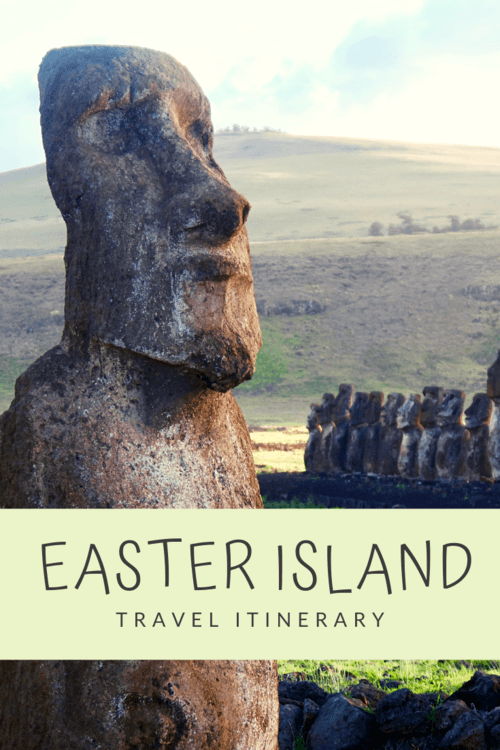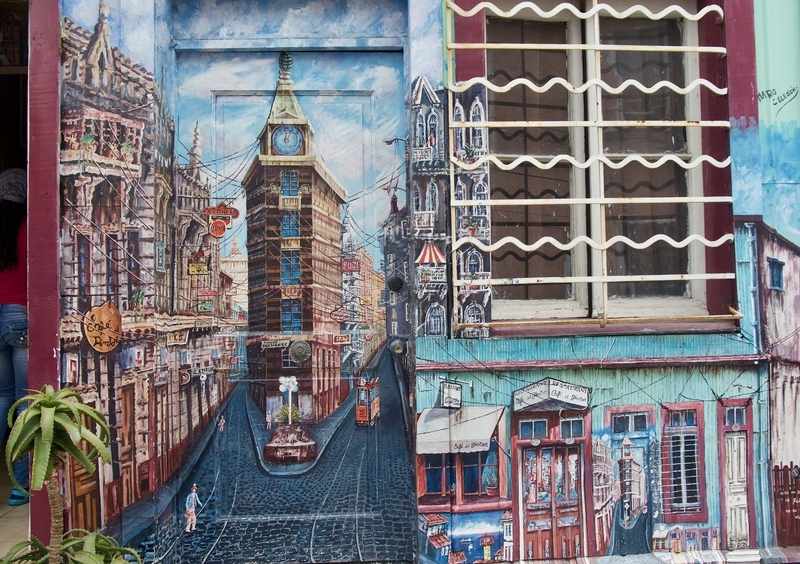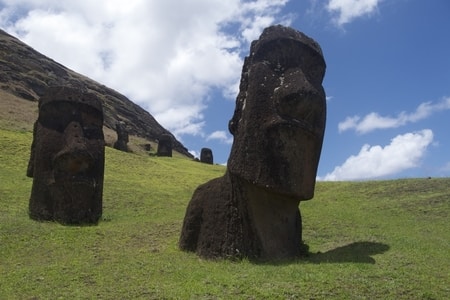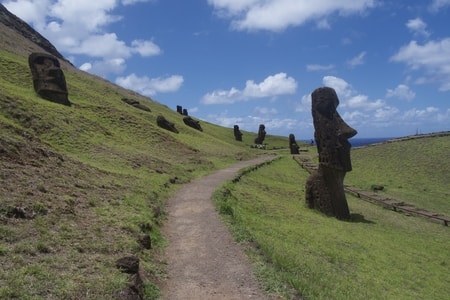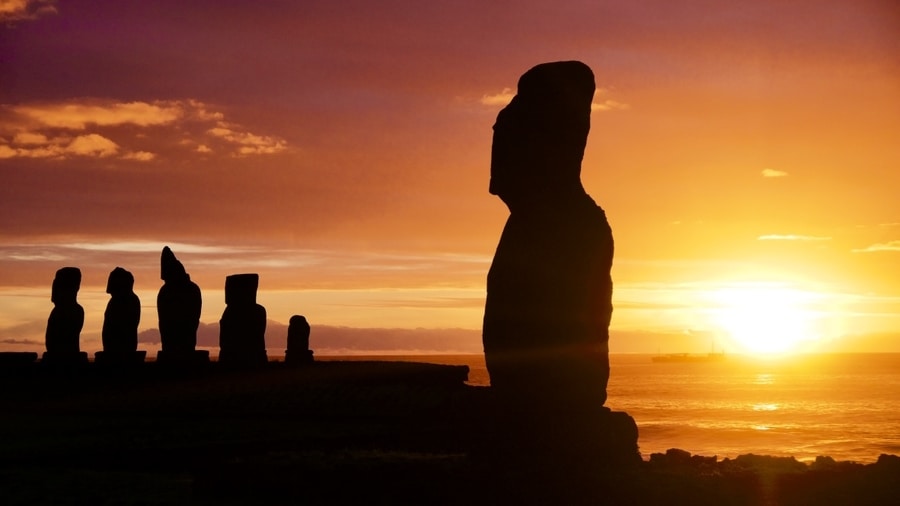
Easter Island 5 Day Itinerary: Things to Do and See
Few places in the world can rival Easter Island when it comes to capturing the imagination of travelers.
Known locally as Rapa Nui, this small speck of land—sitting smack in the middle of the wild Pacific—is like no other places on Earth. The island’s wild beauty and mysterious history have inspired dreamers, enthralled travelers and baffled historians.
Easter Island is Polynesia at its best—still untouched by the masses, still untarnished by overdevelopment and still clinging to a slow-paced lifestyle that runs on island time. Forget cruise ships, mass tourism and eyesore hotels. Here, tourism is on a much smaller scale. Guesthouses and boutique hotels abound. Chain restaurants are nonexistent. And only one daily flight (LATAM’s 787 from Santiago) connects the island to the outside world.
RAPA NUI NATIONAL PARK
Located nearly 2,000 kilometers east of the Pitcairn Islands and about 3,700 kilometers from the coast of Chile, Easter Island is the most remote inhabited place on Earth. The island‘s windswept cliffs are rugged and unspoiled. The island’s colors—its black volcanic rock, its vibrant green grasses and its cobalt ocean—are unlike any I have ever seen. Yet, the island’s wild scenery is not the primary reason that travelers are drawn to its shores. In fact, before I visited Easter Island, I knew little about its stark beauty.
I, like nearly ever other traveler to Rapa Nui National Park, flew thousands of kilometers over the ocean, in hopes of seeing the island’s UNESCO-listed moai statues.
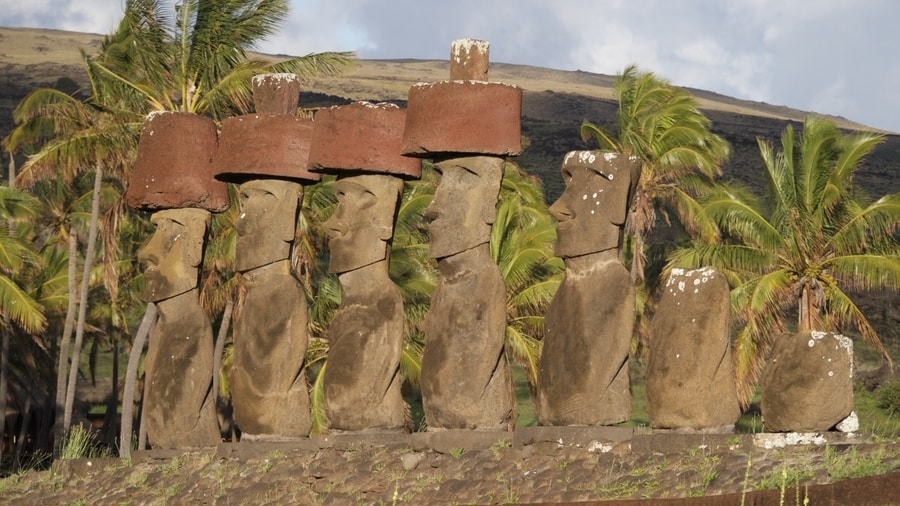
Easter Island’s claim to fame are the nearly 1,000 moai that litter its verdant landscapes of the Rapa Nui National Park. Some stand erect on ceremonial platforms. Others lie toppled on the barren earth. Some are impeccably preserved. Others lie half-finished and partially submerged underground. Though all different, the moai statues of Rapa Nui reveal a rich civilization of master craftsmen and engineers.
THINGS TO DO ON A 5 DAY EASTER ISLAND ITINERARY
We spent four and a half days in Rapa Nui and rented a car for two of them. Having nearly five days on Easter Island, gave us ample time to explore the island’s attractions on foot and with a car.
On our first evening of our Easter Island itinerary, we meandered around the town of Hanga Roa and headed to Ahu Tahei for sunset. On the following days, we hiked the island’s trails and circled its perimeter with our rented Jeep—letting Rapa Nui envelop us in its beauty from sunrise to sunset.
EASTER ISLAND ITINERARY DAY 1: AROUND HANGA ROA
Hanga Roa is Easter Island’s largest (and only) town. With a population of over 3,000, it contains just about all of the island’s guesthouses, tourist amenities and eateries.
After checking into our guesthouse and reserving a rental car for the final two days of our visit, we set out to explore Hanga Roa. We acquainted ourselves with the layout of our surroundings, ate mouthwatering empanada’s at Tia Berta’s and spent the afternoon strolling around its small downtown.
Hanga Roa itself has few tourist attractions, but its main church is an interesting sight. Blending Christian motifs with Polynesian elements, this unique place of worship makes for a brief, yet interesting, visit.
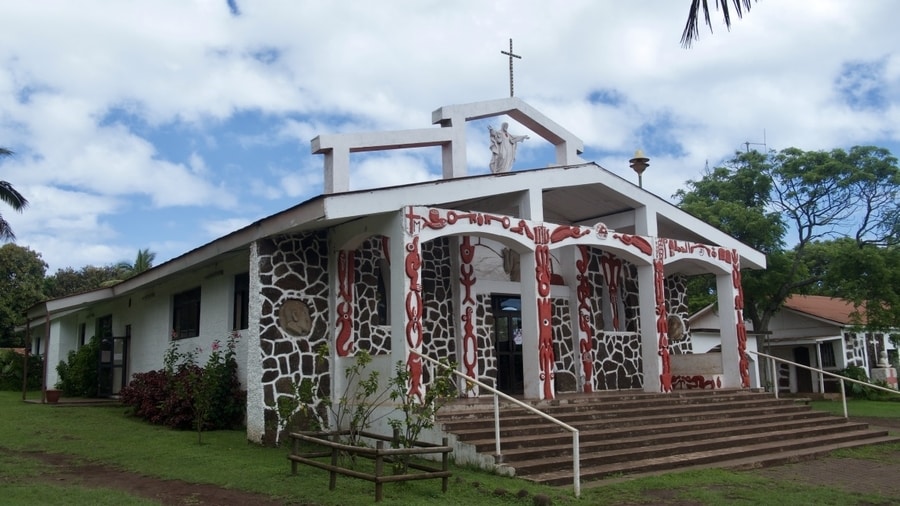
The moai statues of Ahu Tahai are a short walk from downtown Hanga Roa. Restored in 1974, they sit on a grassy field that serves as an open air museum of Rapa Nui culture. A few fully restored and painted moai near Ahu Tahai give an impression of what the sculptures must have looked like centuries ago.
Though smaller and less dramatic than some of the other sites on the island, Ahu Tahai is undeniably Easter Island’s best sunset location.
ITINERARY DAY 2: ORONGO VILLAGE AND RANO KAO VOLCANO
Day two of our five day Easter Island itinerary consisted of a hike up to the Orongo Ruins along the dramatic Easter Island Coastline.
Entrance to the Orongo Ceremonial Village and the Rano Kao Volcano is included in the $80 national park fee. The fee, payable at the airport upon arrival, is valid for six days. Though these tickets grant unlimited access to Rapa Nui’s highlights, the Orongo Ceremonial Village can only be visited once with each ticket purchase.
-
RANO KAO VOLCANO
The pleasant walk to the summit of the crater takes roughly two hours each way. From town, we followed the shoreline south, past the Hanga Piko Harbor and the airport. Once past the airport, we cut inland and followed a well-groomed path up to the summit of the Rano Kao Volcano.
Rano Kao has a crater lake that houses one of the island’s only freshwater reserves. It is among the island’s most impressive geological landmarks and a must-visit Easter Island attraction.
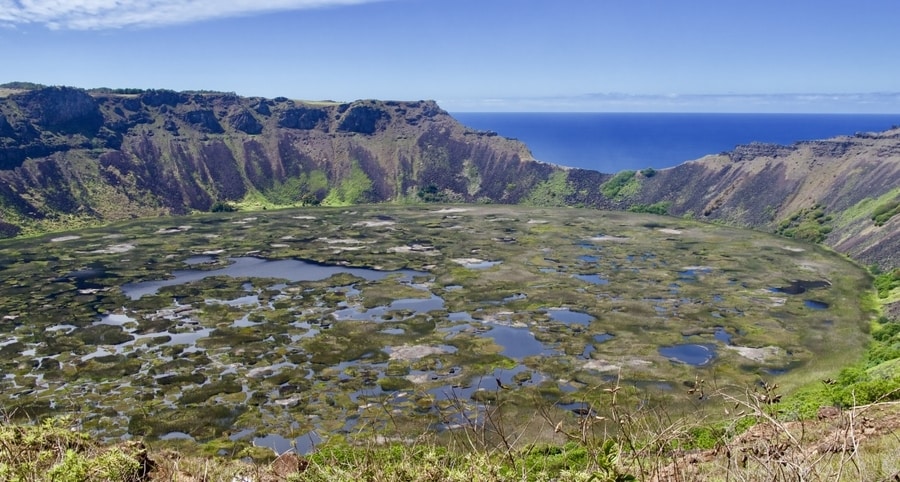
The Orongo Ceremonial Village sits perched precariously between the lip of the Rano Kao Volcano and a cliff that plunges into the cobalt ocean.
-
ORONGO CEREMONIAL VILLAGE
The Orongo Ceremonial Village consists of circular houses that have walls of horizontally overlapping stone slabs. The houses have grass-covered roofs and appear partly subterranean. Near the houses, a cluster of boulders contain petroglyphs with depictions of the birdman.
In the 18th and 19th centuries, Orongo was the focus of an islandwide birdman cult. The birdman competitions took place on the fall equinox every September and consisted of competitors climbing 200 meters down a cliff wall, swimming out to the islet of Motu Nui and retrieving a sooty tern egg. The first competitor to retrieve the egg and return it to the village intact, was declared birdman for the year.
As legend goes, the new birdman would shave off his hair and live in seclusion for a year. During this time, he would achieve god-like status and his kin would join the highest ranks of society. On an island with rapidly-disappearing resources, winning the birdman competition would ensure prosperity for one’s tribe.
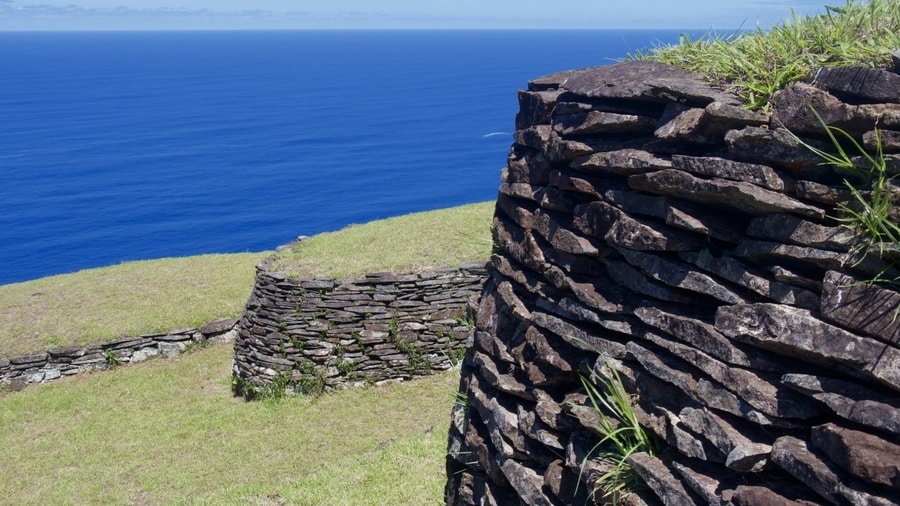
By the time we finished visiting the Orongo Ceremonial Village and returned to Hanga Roa, the sun was already beginning to descend toward the horizon.
So we headed back down to Ahu Tahai and watched, once again, as the sky transformed into a palette of yellows, oranges and reds.
DAY 3: HIKE FROM HANGA ROA TO AHU AKIVI
The third day of our Easter Island itinerary consisted of more walking than the last. We chose to hike along the coast to the north of Hanga Roa, toward the impressive inland moai of Ahu Akivi.
The 17 kilometer loop from Hanga Roa to Ahu Akivi affords scenic views of the island’s wild and rugged coastline. For the first half of the hike, the path runs parallel to the island’s windswept shores–passing a series of subterranean caves and toppled moai. Set against the sapphire ocean, the colors of the landscape are incredibly vibrant. I felt as though I were looking at the world through tinted glasses.
-
AHU AKIVI
The moai statues of Ahu Akivi are unique for many reasons: the fact that they lie inland rather than along the coast, the fact that they are the only moai that face the ocean, and the fact that they stand in astronomically precise alignment.
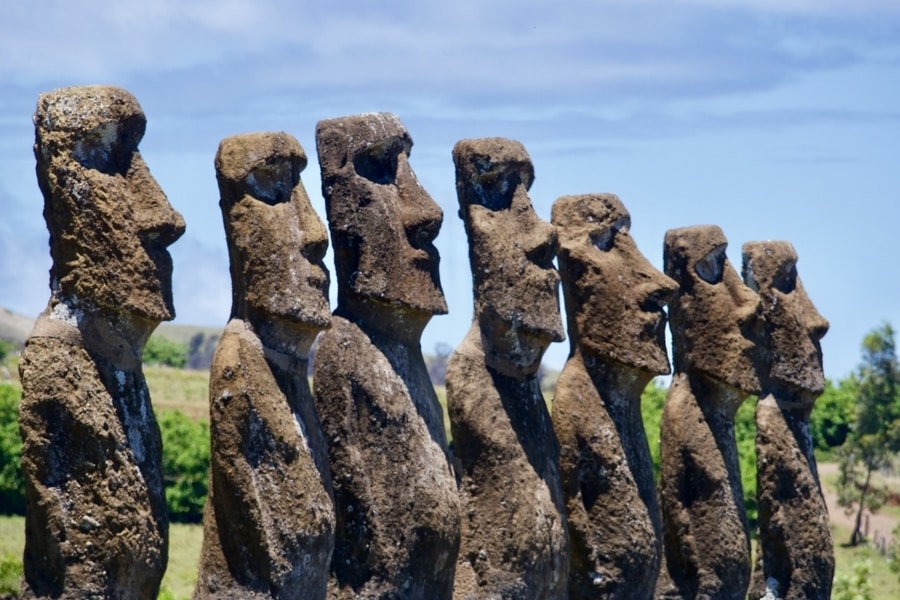
The seven identical statues face sunset during the Spring Equinox and have their backs to sunrise during the Autumn Equinox. For this reason, it is believed that this sacred ahu was the observatory of Rapa Nui.
-
STARK COASTAL LANDSCAPES
Aside from the occasional hiker, we saw few other tourists on the trail to Ahu Akivi. On this remote corner of the island, we found we were far more likely to share the trail with cows and wild horses.
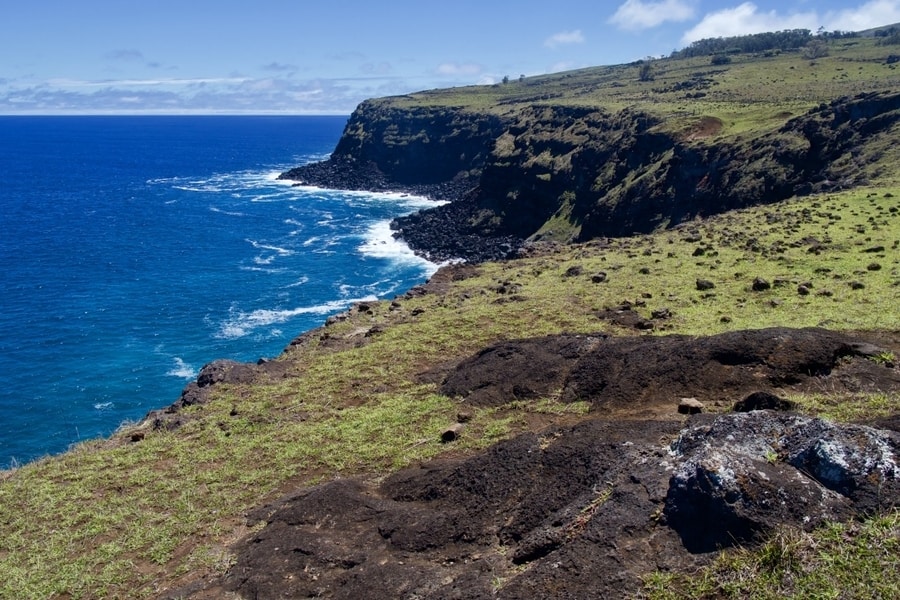
Rapa Nui’s barren landscape has very little shade. Even though a lovely ocean breeze lapped our faces during the hike, the piercing sun drained our energy. For there are few places to find respite in this harsh and uncompromising terrain.
Easter Island was not always treeless, however, and there are various theories as to why the island lost all its vegetation. Some people attribute the deforestation to Rapa Nui’s growing reliance on agriculture. Others argue the trees were chopped down to transport moai. Yet others attribute the loss of trees to invasive rats that were brought from surrounding islands. Perhaps Easter Island’s loss of vegetation is a combination of all three theories. Or perhaps the island lost its forests due to another reason entirely.
Whatever the cause of deforestation, however, the island’s current lack of trees has created an uncompromising and stark landscape that reminded me more of Iceland, than of a Pacific Island.
DAYS 4 AND 5: DRIVE AROUND RAPA NUI
While we were able to access some of Easter Island’s highlights on foot, we soon found that renting a car for a few days was an absolute necessity. Yes, Easter Island is small. But it is far too large to circle on foot and its hilly topography makes cycling less than ideal.
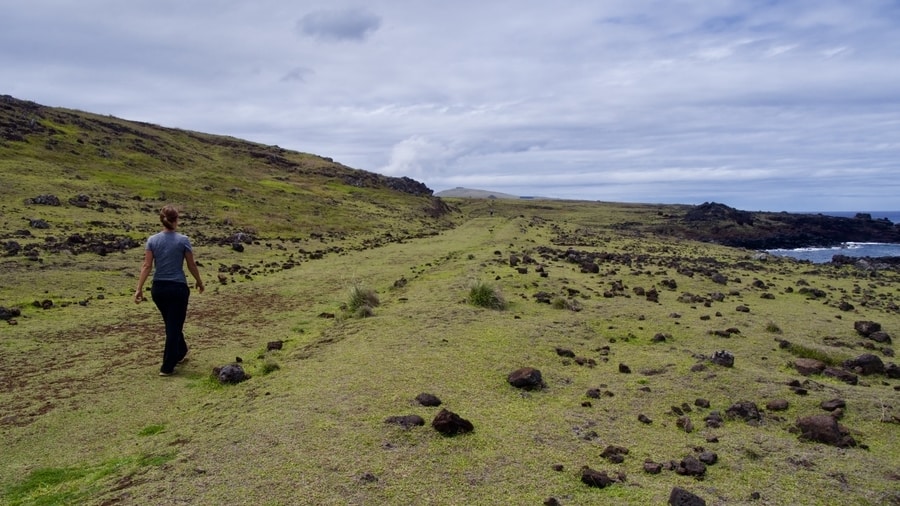
We rented a car from our guesthouse for a daily fee of $50, and chose to spend two days driving around Easter Island. Each day, we circled the island once. Driving around the island twice ensured that we were able to soak in as much as possible–from the main sites, to the lonely moai, to the stunning ocean views.
-
RANO RARAKU QUARRY
On our first day driving, we stayed primarily along the southern coast. We visited more obscure statues and meandered our way to the rock quarry of Rano Raraku–stopping by the smaller sites of Ahu Vinapu and Ahu Akahanga along the way.
Like the Orongo Ceremonial Village, Rano Raraku sits on a volcanic crater and can only be visited once with a ticket to the national park. The archeological site is one of Rapa Nui’s most iconic locations and is known for being the island’s main quarry. For about 500 years, it supplied the rock from which most of the island’s known monolithic sculptures were carved.
On the hill sloping down from the quarry, dozens of moai lay scattered about. Many of these moai are unfinished. Almost all of them still lie partially submerged.
A short trail leads visitors past the ancient quarry’s moai. A secondary path from the ticket control booth wraps around the back side of the mountain into the Rano Raraku Crater. Inside the crater, too, incomplete statues stand half-burried in the ground.
Unfortunately, within minutes of us reaching Rano Raraku, it began to rain. Soon, water pelted down from the skies so ferociously, that it soaked us to the bone. Reluctantly, we returned to our car for cover.
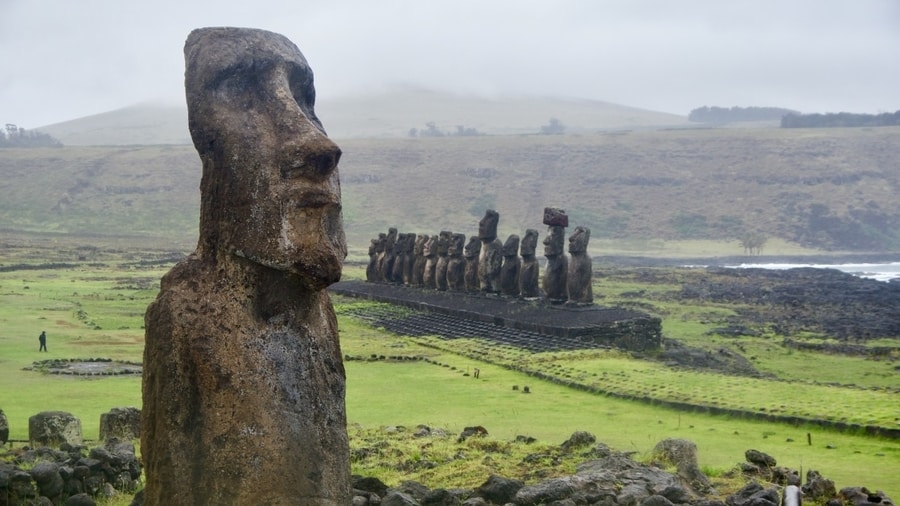
We left Rano Raraku and zoomed around the remainder of the island in counterclockwise fashion–stopping only briefly to snap photos of Ahu Tongariki and Anakena Beach on the way back to Hanga Roa.
-
AHU TONGARIKI
On the final day of our Easter Island itinerary, we started out where we left off. Our first objective was to see the megalithic statues of Ahu Tongariki at sunrise. Ahu Tongariki is one of the most breathtaking sights on the island. Set against a backdrop of sea cliffs and crashing waves, the twelve moai of Easter Island’s largest ahu are a sight to behold.
Luckily, over night the clouds parted and gave way to patches of blue sky–making for a dramatic sunrise behind the silhouetted moai.
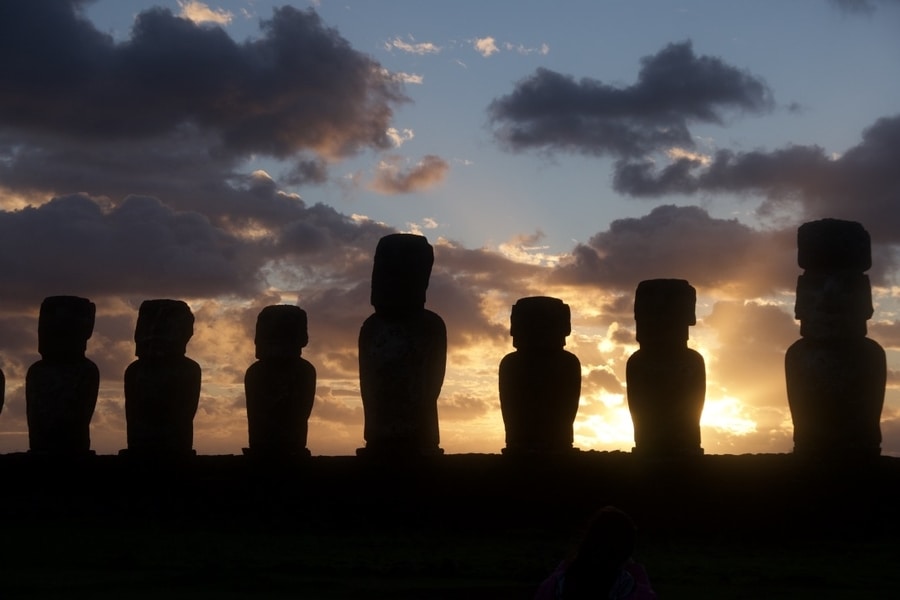
After watching the drama of the sunrise behind Ahu Tongariki, we returned to town for breakfast and a short nap. Then, in the late morning, we retraced our steps from the following day and continued on toward Anakena Beach.
On our counterclockwise circle of the island, we stopped periodically to take in views of the azure sea, the galloping wild horses, and the crumbling moai.
-
ANAKENA BEACH
Anakena Beach lies at the north end of Rapa Nui. It is the island’s only white sand beach and among the most photogenic spots on the island.
The idyllic Easter Island beach has two ahu. One of them is the picturesque Ahu Nau-Nau which has seven moai statues in various states of restoration. The other—Ahu Ature Huke—has only one moai.
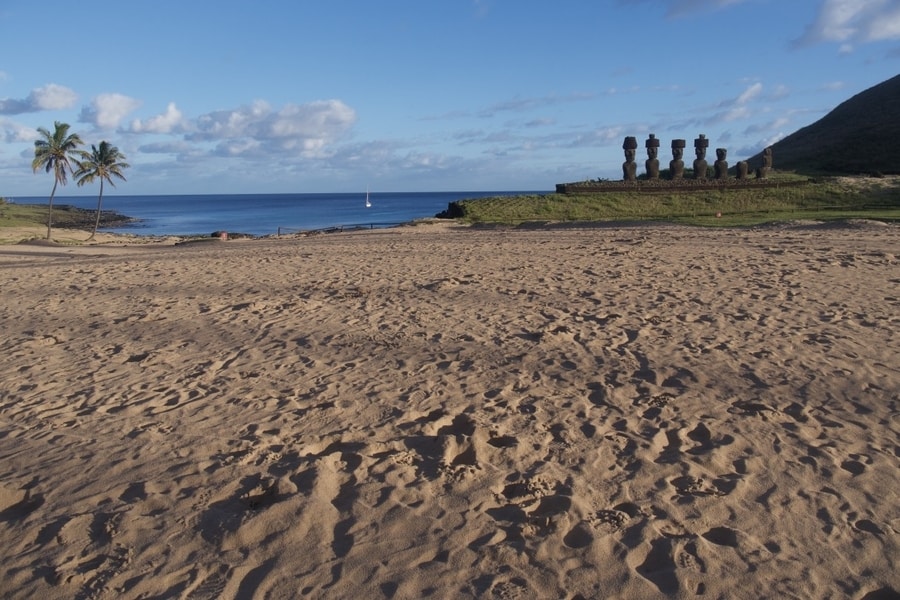
With white sand, sapphire waters, swaying palm trees and regal moai statues, I felt as though I’d entered a dream. This. This must be what paradise looks like, I remember thinking.
WHERE TO STAY ON EASTER ISLAND
Easter Island is not a particularly accommodating destination for budget travelers. In fact, though it is technically a South American territory, I found Easter Island’s prices to be on par with Palau, French Polynesia and many Caribbean Islands.
We chose to stay at Hostal Petero Atamu for the entirety of our five day Easter Island itinerary. The guesthouse–offering basic, yet clean private and shared accommodation–allowed us to enjoy one of the most expensive places on Earth at a reasonable price.
For travelers with a more flexible budget, Easter Island can be much more accommodating. Hare Nua Hotel Boutique and Kona Koa Lodge seem to be great mid-range options, while the Nayara Hangaroa offers a slice of luxury at a higher price point.
****
Easter Island feels worlds away from the humdrum of daily life. The island appears to sit at the edge of the world. Its remote location made me feel as though sailing off its shores would cause me to fall right off the map.
Due in part it its remoteness, the island is full of superlatives. It is magical. Mystifying. Spectacular.
And it is so historically, culturally and geographically removed from everywhere else on Earth, that there’s just no other place like it.
_______________
Like this Easter Island Travel Itinerary? Pin it!
